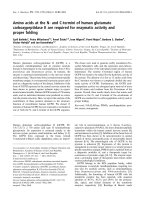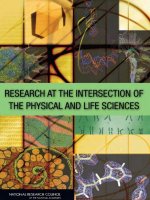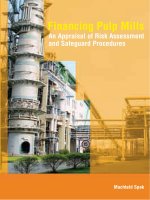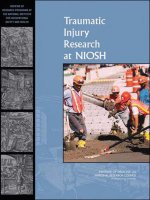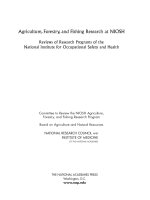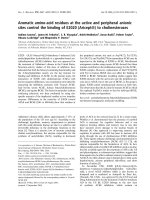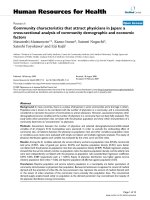- Trang chủ >>
- Khoa Học Tự Nhiên >>
- Vật lý
Research at the Intersection of the Physical and Life Sciences potx
Bạn đang xem bản rút gọn của tài liệu. Xem và tải ngay bản đầy đủ của tài liệu tại đây (5.36 MB, 123 trang )
Copyright © National Academy of Sciences. All rights reserved.
Research at the Intersection of the Physical and Life Sciences
Committee on Research at the Intersection of the Physical and Life Sciences
Board on Physics and Astronomy
Board on Life Sciences
Board on Chemical Sciences and Technology
Division on Engineering and Physical Sciences
Division on Earth and Life Studies
Research at the Intersection of
the Physical and Life Sciences
Copyright © National Academy of Sciences. All rights reserved.
Research at the Intersection of the Physical and Life Sciences
THE NATIONAL ACADEMIES PRESS 500 Fifth Street, N.W. Washington, DC 20001
NOTICE: The project that is the subject of this report was approved by the Governing Board of the
National Research Council, whose members are drawn from the councils of the National Academy
of Sciences, the National Academy of Engineering, and the Institute of Medicine. The members of
the committee responsible for the report were chosen for their special competences and with regard
for appropriate balance.
This project was supported by the Department of Energy under Award No. DE-FG02-07ER46378,
the National Science Foundation under Award No. CHE-0554275, the Department of Health and
Human Services under Award No. N01-OD-4-2139, the Burroughs Wellcome Fund under Award
No. 1007560, and the Research Corporation for Science Advancement under Award No. 7827. Any
opinions, findings, conclusions, or recommendations expressed in this publication are those of the
author(s) and do not necessarily reflect the views of the sponsors.
International Standard Book Number-13: 978-0-309-14751-4
International Standard Book Number-10: 0-309-14751-4
Library of Congress Control Number: 2010921434
Cover: Work at the intersection of the life sciences and the physical sciences has often been depicted
in new ways of imaging or modeling biological specimens, some of which are illustrated on the
cover: (1) three-dimensional distribution of membrane proteins within a cell
revealed through iPALM imaging (courtesy of Harald F. Hess, Howard Hughes
Medical Institute); (2) xylose isomerase crystal (courtesy of Department of
Energy Office of Basic Energy Research (BER)-funded neutron Protein Crystal-
lography Station at Los Alamos National Laboratory (LANL)); (3) simulation
of confinement of DNA in viral capsid (courtesy of Molecular Dynamics and
Statistical Mechanics Research Group, University of Wisconsin at Madison);
(4) diffusion tension imaging of the human brain (courtesy of Thomas Schultz,
University of Chicago); (5) chromosome pairs; (6) modeled structure for
the enzyme D-xylose isomerase (courtesy of Department of Energy BER-
funded neutron Protein Crystallography Station at LANL; (7) anglerfish ovary
obtained using autofluorescence (courtesy of James E. Hayden, Wistar Institute,
Philadelphia); and (8) rat cerebellum obtained using two-photon excitation
fluorescence microscopy (courtesy of the National Center for Microscopy and Imaging Research at
the University of California at San Diego and the National Institutes of Health.
IMAGE SOURCES: (1) Harald F. Hess, Howard Hughes Medical Institute; (2) Department of Energy
Office of Basic Energy Research (BER)-funded neutron Protein Crystallography Station at Los Alamos
National Laboratory (LANL); (3) Molecular Dynamics and Statistical Mechanics Research Group,
University of Wisconsin at Madison; (4) Thomas Schultz, University of Chicago; (6) Department of
Energy BER-funded neutron Protein Crystallography Station at LANL; (7) James E. Hayden, Wistar
Institute, Philadelphia; and (8) National Center for Microscopy and Imaging Research at the Univer-
sity of California at San Diego and the National Institutes of Health.
Copies of this report are available from: National Academies Press, 500 Fifth Street, N.W., Washington,
DC 20055; (800) 624-6242 or (202) 334-3313 (in the Washington metropolitan area); Internet <http://
www.nap.edu>; and the Board on Physics and Astronomy, National Research Council, 500 Fifth Street,
N.W., Washington, DC 20001; Internet < />Copyright 2010 by the National Academy of Sciences. All rights reserved.
Printed in the United States of America
Copyright © National Academy of Sciences. All rights reserved.
Research at the Intersection of the Physical and Life Sciences
The National Academy of Sciences is a private, nonprofit, self-perpetuating society of distinguished
scholars engaged in scientific and engineering research, dedicated to the furtherance of science and
technology and to their use for the general welfare. Upon the authority of the charter granted to it
by the Congress in 1863, the Academy has a mandate that requires it to advise the federal govern-
ment on scientific and technical matters. Dr. Ralph J. Cicerone is president of the National Academy
of Sciences.
The National Academy of Engineering was established in 1964, under the charter of the National
Academy of Sciences, as a parallel organization of outstanding engineers. It is autonomous in its
administration and in the selection of its members, sharing with the National Academy of Sciences
the responsibility for advising the federal government. The National Academy of Engineering also
sponsors engineering programs aimed at meeting national needs, encourages education and research,
and recognizes the superior achievements of engineers. Dr. Charles M. Vest is president of the National
Academy of Engineering.
The Institute of Medicine was established in 1970 by the National Academy of Sciences to secure
the services of eminent members of appropriate professions in the examination of policy matters
pertaining to the health of the public. The Institute acts under the responsibility given to the National
Academy of Sciences by its congressional charter to be an adviser to the federal government and, upon
its own initiative, to identify issues of medical care, research, and education. Dr. Harvey V. Fineberg
is president of the Institute of Medicine.
The National Research Council was organized by the National Academy of Sciences in 1916 to associate
the broad community of science and technology with the Academy’s purposes of furthering knowledge
and advising the federal government. Functioning in accordance with general policies determined by
the Academy, the Council has become the principal operating agency of both the National Academy
of Sciences and the National Academy of Engineering in providing services to the government, the
public, and the scientific and engineering communities. The Council is administered jointly by both
Academies and the Institute of Medicine. Dr. Ralph J. Cicerone and Dr. Charles M. Vest are chair and
vice chair, respectively, of the National Research Council.
www.national-academie s.org
Copyright © National Academy of Sciences. All rights reserved.
Research at the Intersection of the Physical and Life Sciences
Copyright © National Academy of Sciences. All rights reserved.
Research at the Intersection of the Physical and Life Sciences
v
COMMITTEE ON RESEARCH AT THE INTERSECTION OF THE
PHYSICAL AND LIFE SCIENCES
ERIN K. O’SHEA, Co-Chair, Harvard University
PETER G. WOLYNES, Co-Chair, University of California at San Diego
ROBERT H. AUSTIN, Princeton University
BONNIE L. BASSLER, Princeton University
CHARLES R. CANTOR, Sequenom, Inc.
WILLIAM F. CARROLL, Occidental Chemical Corporation
THOMAS R. CECH, Howard Hughes Medical Institute
CHRISTOPHER B. FIELD, Carnegie Institution Department of Global Ecology
GRAHAM R. FLEMING, University of California at Berkeley
ROBERT J. FULL, University of California at Berkeley
SHIRLEY ANN JACKSON, Rensselaer Polytechnic Institute
LAURA L. KIESSLING, University of Wisconsin at Madison
CHARLES M. LOVETT, JR., Williams College
DIANNE NEWMAN, Massachusetts Institute of Technology
MONICA OLVERA de la CRUZ, Northwestern University
JOSÉ N. ONUCHIC, University of California at San Diego
GREGORY A. PETSKO, Brandeis University
ASTRID PRINZ, Emory University
CHARLES V. SHANK, Lawrence Berkeley National Laboratory (retired)
BORIS I. SHRAIMAN, University of California at Santa Barbara
H. EUGENE STANLEY, Boston University
GEORGE M. WHITESIDES, Harvard University
Staff
DONALD C. SHAPERO, Director, Board on Physics and Astronomy
FRANCES E. SHARPLES, Director, Board on Life Sciences
DOROTHY ZOLANDZ, Director, Board on Chemical Sciences and Technology
ADAM P. FAGEN, Senior Program Officer, Board on Life Sciences
JAMES C. LANCASTER, Program Officer, Board on Physics and Astronomy
KATHRYN J. HUGHES, Program Officer, Board on Chemical Sciences and
Technology
NATALIA MELCER, Program Officer, Board on Physics and Astronomy
LAVITA COATES-FOGLE, Senior Program Assistant
Copyright © National Academy of Sciences. All rights reserved.
Research at the Intersection of the Physical and Life Sciences
vi
SOLID STATE SCIENCES COMMITTEE
BARBARA JONES, Chair, IBM Almaden Research Center
MONICA OLVERA de la CRUZ, Vice-Chair, Northwestern University
DANIEL AROVAS, University of California at San Diego
COLLIN L. BROHOLM, The Johns Hopkins University
PAUL CHAIKIN, New York University
GEORGE CRABTREE, Argonne National Laboratory
ANDREA J. LIU, University of Pennsylvania
JOSEPH ORENSTEIN, University of California at Berkeley
ARTHUR P. RAMIREZ, LGS, a subsidiary of Alcatel-Lucent, and Columbia
University
RICHARD A. REGISTER, Princeton University
MARK STILES, National Institute of Standards and Technology
DALE J. VAN HARLINGEN, University of Illinois at Urbana-Champaign
FRED WUDL, University of California at Santa Barbara
Staff
DONALD C. SHAPERO, Director, Board on Physics and Astronomy
MICHAEL H. MOLONEY, Associate Director
JAMES C. LANCASTER, Program Officer
LAVITA COATES-FOGLE, Senior Program Assistant
BETH DOLAN, Financial Associate
Copyright © National Academy of Sciences. All rights reserved.
Research at the Intersection of the Physical and Life Sciences
vii
BOARD ON PHYSICS AND ASTRONOMY
MARC A. KASTNER, Chair, Massachusetts Institute of Technology
ADAM S. BURROWS, Vice-Chair, University of Arizona
JOANNA AIZENBERG, Harvard University
JAMES E. BRAU, University of Oregon
PHILIP H. BUCKSBAUM, Stanford University
PATRICK L. COLESTOCK, Los Alamos National Laboratory
RONALD C. DAVIDSON, Princeton University
ANDREA M. GHEZ, University of California at Los Angeles
PETER F. GREEN, University of Michigan
LAURA H. GREENE, University of Illinois at Urbana-Champaign
MARTHA P. HAYNES, Cornell University
JOSEPH HEZIR, EOP Group, Inc.
MARK KETCHEN, IBM Thomas J. Watson Research Center
ALLAN H. MacDONALD, University of Texas at Austin
PIERRE MEYSTRE, University of Arizona
HOMER A. NEAL, University of Michigan
JOSE N. ONUCHIC, University of California at San Diego
LISA J. RANDALL, Harvard University
CHARLES V. SHANK, Lawrence Berkeley National Laboratory (retired)
MICHAEL S. TURNER, University of Chicago
MICHAEL C.F. WIESCHER, University of Notre Dame
Staff
DONALD C. SHAPERO, Director
MICHAEL H. MOLONEY, Associate Director
ROBERT L. RIEMER, Senior Program Officer
JAMES C. LANCASTER, Program Officer
DAVID B. LANG, Program Officer
CARYN J. KNUTSEN, Research Associate
BETH DOLAN, Financial Associate
Copyright © National Academy of Sciences. All rights reserved.
Research at the Intersection of the Physical and Life Sciences
viii
BOARD ON LIFE SCIENCES
KEITH YAMAMOTO, Chair, University of California at San Francisco
ANN M. ARVIN, Stanford University
BONNIE L. BASSLER, Princeton University
VICKI L. CHANDLER, Gordon and Betty Moore Foundation
SEAN EDDY, HHMI Janelia Farm Research Campus
MARK D. FITZSIMMONS, John D. and Catherine T. MacArthur Foundation
DAVID R. FRANZ, Midwest Research Institute
LOUIS J. GROSS, University of Tennessee at Knoxville
JO HANDELSMAN, University of Wisconsin at Madison
CATO T. LAURENCIN, University of Connecticut
JONATHAN D. MORENO, University of Pennsylvania
ROBERT M. NEREM, Georgia Institute of Technology
CAMILLE PARMESAN, University of Texas at Austin
MURIEL E. POSTON, Skidmore College
ALISON G. POWER, Cornell University
BRUCE W. STILLMAN, Cold Spring Harbor Laboratory
CYNTHIA WOLBERGER, Johns Hopkins University School of Medicine
MARY WOOLLEY, Research! America
Staff
FRANCES E. SHARPLES, Director
JO L. HUSBANDS, Scholar/Senior Project Director
ADAM P. FAGEN, Senior Program Officer
ANN H. REID, Senior Program Officer
MARILEE K. SHELTON-DAVENPORT, Senior Program Officer
INDIA HOOK-BARNARD, Program Officer
ANNA FARRAR, Financial Associate
CARL-GUSTAV ANDERSON, Senior Program Assistant
AMANDA P. CLINE, Senior Program Assistant
AMANDA MAZZAWI, Program Assistant
Copyright © National Academy of Sciences. All rights reserved.
Research at the Intersection of the Physical and Life Sciences
ix
BOARD ON CHEMICAL SCIENCES AND TECHNOLOGY
F. FLEMING CRIM, Co-Chair, University of Wisconsin at Madison
GARY S. CALABRESE, Co-Chair, Corning, Inc.
BENJAMIN ANDERSON, Lilly Research Laboratories
PABLO G. DEBENEDETTI, Princeton University
RYAN R. DIRKX, Arkema, Inc.
MARY GALVIN-DONOGHUE, Air Products and Chemicals Materials
PAULA T. HAMMOND, Massachusetts Institute of Technology
CAROL J. HENRY, Advisor and Consultant
RIGOBERTO HERNANDEZ, Georgia Institute of Technology
CHARLES E. KOLB, Aerodyne Research, Inc.
MARTHA A. KREBS, California Energy Commission
CHARLES T. KRESGE, Dow Chemical Company
SCOTT J. MILLER, Yale University
DONALD PROSNITZ, RAND Corporation
MARK A. RATNER, Northwestern University
ERIK J. SORENSEN, Princeton University
WILLIAM C. TROGLER, University of California at San Diego
THOMAS H. UPTON, ExxonMobil
Staff
DOROTHY ZOLANDZ, Director
ANDREW CROWTHER, Postdoctoral Research Associate
KATHRYN J. HUGHES, Program Officer
TINA MASCIANGIOLI, Senior Program Officer
ERICKA McGOWAN, Associate Program Officer
JESSICA L. PULLEN, Administrative Assistant
SHEENA SIDDIQUI, Research Assistant
LYNELLE VIDALE, Project Assistant
Copyright © National Academy of Sciences. All rights reserved.
Research at the Intersection of the Physical and Life Sciences
Copyright © National Academy of Sciences. All rights reserved.
Research at the Intersection of the Physical and Life Sciences
xi
This report has been reviewed in draft form by individuals chosen for their
diverse perspectives and technical expertise, in accordance with procedures approved
by the National Research Council’s Report Review Committee. The purpose of this
independent review is to provide candid and critical comments that will assist the
institution in making its published report as sound as possible and to ensure that
the report meets institutional standards for objectivity, evidence, and responsive-
ness to the study charge. The review comments and draft manuscript remain
confidential to protect the integrity of the deliberative process. We wish to thank
the following individuals for their review of this report:
Marlene Belfort, New York State Department of Health
Robert Dimeo, National Institute of Standards and Technology
James Heath, California Institute of Technology
Jennifer Lippincott-Schwartz, National Institutes of Health
Andrea Liu, University of Pennsylvania
Peter Moore, Yale University
Aravi Samuel, Harvard University
Philip Sharp, Massachusetts Institute of Technology
Erik Sorensen, Princeton University
Although the reviewers listed above have provided many constructive com-
ments and suggestions, they were not asked to endorse the conclusions or recom-
mendations, nor did they see the final draft of the report before its release. The
Acknowledgment of Reviewers
Copyright © National Academy of Sciences. All rights reserved.
Research at the Intersection of the Physical and Life Sciences
xii
A c k n o w l e d g m e n t o f R e v i e w e R s
review of this report was overseen by W. Carl Lineberger, University of Colorado
at Boulder. Appointed by the National Research Council, he was responsible for
making certain that an independent examination of this report was carried out in
accordance with institutional procedures and that all review comments were care-
fully considered. Responsibility for the final content of this report rests entirely
with the authoring committee and the institution.
Copyright © National Academy of Sciences. All rights reserved.
Research at the Intersection of the Physical and Life Sciences
xiii
Contents
SUMMARY 1
1 INTRODUCTION 9
2 GRAND CHALLENGES 12
Grand Challenge 1. Synthesizing Lifelike Systems, 12
Grand Challenge 2. Understanding the Brain, 14
Grand Challenge 3. Predicting Individual Organisms’ Characteristics
from Their DNA Sequence, 15
Grand Challenge 4. Interactions of the Earth, Its Climate, and the
Biosphere, 16
Grand Challenge 5. Understanding Biological Diversity, 18
3 SOCIETAL CHALLENGES 20
Identifying and Combating Biological Threats, 21
Early Detection and Intervention, 21
Prediction of Susceptibility to Disease and Its Prevention, 22
Climate and Its Interface with Biology, 23
Complex Feedback Loops in Climate Science, 23
Implications of Renewable Energy, 23
Medicine, 24
Imaging, 24
Treatment and Devices, 25
Copyright © National Academy of Sciences. All rights reserved.
Research at the Intersection of the Physical and Life Sciences
xiv
c o n t e n t s
Agriculture as a Resource for Food and Energy, 25
Building Better Plants and Getting More Out of Them, 26
Hydrogenases and Synthetic Photosynthesis, 27
Beyond Combustion, 27
Materials Science, 28
Opportunities, 28
References, 29
4 COMMON THEMES AT THE INTERSECTION OF BIOLOGICAL 30
AND PHYSICAL SCIENCES
Interaction and Information: From Molecules to Organisms and
Beyond, 30
Dynamics, Multistability, and Stochasticity, 36
Self-organization and Self-assembly, 42
Conclusion, 48
References, 49
5 ENABLING TECHNOLOGIES AND TOOLS FOR RESEARCH 51
Introduction, 51
Physical Basis of Molecular Recognition, 52
Structures and Dynamics Within Cells, 53
Cellular Environment, 53
Interactions Within Cells, 55
Examining Structures Within Cells, 56
Theory and Simulations, 60
Collective Dynamics, 64
Complex Community Signals and Shared Resources at Large Length
Scales, 65
References, 68
6 ENABLING RESEARCH AT THE INTERSECTION: PROMOTING 69
TRAINING, SUPPORT, AND COMMUNICATION ACROSS
DISCIPLINES
Connections Between Disciplines, 70
Culture of Separation Between the Life and Physical Sciences, 70
Culture and Organization of Academia, 72
Organization of Support for Research, 73
Supporting Transformative Research, 78
Educating Scientists at the Intersection of the Physical and Life
Sciences, 82
Copyright © National Academy of Sciences. All rights reserved.
Research at the Intersection of the Physical and Life Sciences
xv
c o n t e n t s
Enabling Interdisciplinary Research Starting at the Undergraduate
Level, 82
Integrating Life and Physical Sciences for Graduate Students and
Postdoctoral Researchers, 85
References, 89
APPENDIXES
A Statement of Task 93
B Meeting Agendas 94
C Biographies of Committee Members 99
Copyright © National Academy of Sciences. All rights reserved.
Research at the Intersection of the Physical and Life Sciences
Copyright © National Academy of Sciences. All rights reserved.
Research at the Intersection of the Physical and Life Sciences
1
“. . . the action most worth watching is not at the center of things but where
edges meet . . . shorelines, weather fronts, international borders . . .”
Anne Fadiman, The Spirit Catches You and You Fall Down
Almost since their inception, the natural sciences, those fields that use the sci-
entific method to study nature, have been divided into two branches: the biological
sciences and the physical sciences. In part, this division can be viewed as a con-
venient social contrivance. However, over time it has also served more functional
purposes. Physical scientists, when seeking the fundamental laws, have found it
necessary to focus on the simplest of systems—elementary particles, atoms, and
molecules—items clearly not alive. It also has been convenient for biological scien-
tists to investigate the immense diversity of living things and their elaborate inner
workings without simultaneously accepting the burden of trying to follow these
complexities down to their atomic level roots.
Today, while it still is convenient to classify most research in the natural sciences
as either biological or physical, more and more scientists are quite deliberately and
consciously addressing problems lying at the intersection of these traditional areas.
This report focuses on their efforts. As directed by the charges in the statement
of task (see Appendix A), the goals of the committee in preparing this report are
several fold. The first goal is to provide a conceptual framework for assessing work
in this area—that is, a sense of coherence for those not engaged in this research
Summary
Copyright © National Academy of Sciences. All rights reserved.
Research at the Intersection of the Physical and Life Sciences
R e s e A R c h A t t h e i n t e R s e c t i o n o f t h e P h y s i c A l A n d l i f e s c i e n c e s
2
about the big objectives of the field and why it is worthy of attention from fellow
scientists and programmatic focus by funding agencies. The second goal is to assess
current work using that framework and to point out some of the more promising
opportunities for future efforts, such as research that could significantly benefit
society. The third and final goal of the report is to set out strategies for realizing
those benefits—ways to enable and enhance collaboration so that the United States
can take full advantage of the opportunities at this intersection.
CONCEPTUAL FRAMEWORK FOR ASSESSING THIS INTERSECTION
Any attempt to provide an all-inclusive framework for this work will inevitably
leave out research that belongs within it. With that caveat, a good way to think of
research at this intersection is that it turns ways of looking at things—both figu-
ratively and literally—from their original purpose and uses them to tackle new
problems, often in ways far removed from when they were first conceived.
Most—but not all—of the new problems being addressed at this intersection
are biological ones, largely because of the incredible richness of this field. The realm
of biology is immense, involving complicated structures as small as molecules and
as large as the biosphere and timescales that range from submicroseconds to eons.
Answers to these problems seek not only to describe how the individual structures,
in their immense complexity and diversity, work but also how they interplay. A very
rich source of potential questions indeed.
The ways of looking often come from the physical sciences. Those ways might
be conceptual—approaches for looking at and solving problems—or analytical—
methods for extracting understanding from data—or technical—tools for collect-
ing information needed to address the problem at hand. But it is this intermingling
of problems from one arena and ways of looking at them from another arena that
makes this intersectional area between the biological and physical sciences so rich
and offers many of the opportunities that reside there. The committee expects that
ideas will emerge from such studies that will go well beyond the intersection and
transform both the biological and physical sciences.
CURRENT WORK AT THE INTERSECTION
What, then, are some of the areas being explored at this intersection? Interest-
ingly, many share common conceptual themes, several of which are discussed in this
report. Interactions appear in both branches, albeit with much different content
and contexts. Describing how individual particles interact—what forces and energy
exchanges cause crystalline materials to form, and matter in all phases to display
characteristic behavior and to undergo phase changes—are mainstays of the world
of physics. However, these ways of thinking about and discussing how inanimate
Copyright © National Academy of Sciences. All rights reserved.
Research at the Intersection of the Physical and Life Sciences
3
s u m m A R y
objects interact have been found useful to scientists attempting to answer questions
about the interplay of biological matter at many different levels.
Another area finding fertile ground and producing fruitful cross-research
opportunities centers on the dynamics of systems. Equilibrium, multistability, and
stochastic behavior—concepts familiar to physicists and chemists—are now being
used to tackle issues involved in living systems such as adaptation, feedback, and
emergent behavior. Ideas of pattern formation that are at the heart of condensed
matter physics now help us to understand biological self-assembly and the devel-
opment of biological systems.
This report also discusses how some of the mysteries of the biological world
have been unraveled using tools and techniques developed in the physical sciences.
These tools include not only imaging devices, both photon- and matter-based,
but also computational models and algorithms. While many of them are used
interchangeably by the two fields, others must be modified. However, to reach the
heart of biological systems, even more sophisticated investigatory technologies
and tools will be needed, many of which have not even been imagined much less
developed.
In preparing this report, the committee was mindful of the vastness of the
number of topics that arguably comes within the ambit of this report’s subject
matter. Work taking place at the intersections of engineering and the life sciences
and of materials development and the life sciences covers but two of such topics.
Both are fascinating examples of where the meshing of different cultures and sets
of ideas can produce much fruitful discussion and advancement.
1
However, the
statement of task for this committee focuses on research, limiting this report to
more basic activities than those typically involved in engineering and materials
development. Further, the committee acknowledges that the research that is the
subject matter of this report both arises from and depends upon the rich, ongoing
efforts taking place within the core disciplines of the physical and life sciences. Such
intersectional research serves to supplement rather than to supplant the scientific
advances being made in the more traditional fields.
PROMISING OPPORTUNITIES FOR FUTURE EFFORTS
Some of the most fundamental challenges in this area and near-term pros-
pects for successfully meeting them are discussed in the form of five Grand
Challenges:
1
Some have been covered in other NRC reports. See, for example, Inspired by Biology: From
Molecules to Materials to Machines, Washington, D.C.: The National Academies Press (2008) and A
New Biology for the 21st Century, Washington, D.C.: The National Academies Press (2009). Others
might be the focus of future reports.
Copyright © National Academy of Sciences. All rights reserved.
Research at the Intersection of the Physical and Life Sciences
R e s e A R c h A t t h e i n t e R s e c t i o n o f t h e P h y s i c A l A n d l i f e s c i e n c e s
4
• Grand Challenge 1. Natural substances display remarkable architecture,
demonstrating the immense breadth of what can be achieved in developing
structures and systems. Can the skills and knowledge-sets of biological and
physical scientists be combined to provide greater insight into identifying
those structures, capabilities, and processes that form the basis for living
systems, and then to use that insight to construct systems with some of the
characteristics of life that are capable, for example, of synthesizing materials
or carrying out functions as yet unseen in natural biology?
•
Grand Challenge 2. The human brain may be nature’s most complex sys-
tem. Can we understand how it works and build on that understanding to
predict brain function? Addressing this challenge will require drawing on
the resources of the physical sciences, both existing and to be developed,
from imaging techniques to modeling capabilities.
•
Grand Challenge 3. Genes and the environment interact to produce living
organisms. Can we deepen our understanding of those interactions to begin
to comprehend how organisms change over time—how they age and heal,
for example—and from that understanding realize the promise of personal-
ized medicine and access to better health care?
•
Grand Challenge 4. Earth interacts with its climate and the biosphere
through strikingly different yet intertwined mechanisms that operate over
vast ranges of time and space. Can life and physical scientists develop
an effective approach for understanding how these mechanisms interplay
and use that understanding to develop strategies that will preserve this
heritage?
• Grand Challenge 5. Living systems display remarkable diversity, serving to
protect communities from harm. This diversity is declining, however, as the
result of human activities, yet efforts to understand its role in the health of a
species or an ecosystem have only recently been undertaken. Can knowledge
gained at the intersection of the life and physical sciences teach us how to
prosper while sustaining the diversity that allows life to flourish?
Further research at this intersection not only will advance our understanding
of the fundamental questions of science, but will also significantly impact public
health, technology, and stewardship of the environment for the benefit of society.
In the world of technology, our economy clearly is based on materials, but no
synthetic material in use today is as complex as a dead piece of wood, let alone a
living organism. Prospects for a material world as adaptive and robust as living
things have been the stuff of science fiction for decades. To achieve these dreams
requires a greater understanding of the organizing principles of life. For public
Copyright © National Academy of Sciences. All rights reserved.
Research at the Intersection of the Physical and Life Sciences
5
s u m m A R y
health, the complexity of molecular recognition and the emergent regulation of
physiology must be better understood if drug design is to progress from the art
it is to engineering science. Without understanding the diversity encompassed in
human biology, personalized medicine will remain more a hope than a reality.
We often think of environmental challenges as being biological (“Save the
whales!”) or physical (“Limit greenhouse gases!”) but, again, this distinction
between the disciplines is a distortion. The constant interplay between the bio-
logical sciences and the physical sciences is profound when Earth is viewed as an
entire system.
STRATEGIES FOR ENABLING AND ENHANCING WORK
AT THE INTERSECTION
Throughout the report, the committee recommends ways to accelerate progress
in this field. Some of these recommendations are implicit. By describing the vast
array of outstanding questions at this intersection, it hopes to intrigue some of its
fellow scientists to venture into this area and perhaps find interesting questions
to address. Of the report’s explicit recommendations, several are directed to those
administering the faculties and resources of our great research institutions. In both
the academic and business world, the cultures of the biological and physical sci-
ences have evolved separately. Indeed both of these broad areas maintain numerous
subcultures within themselves. It might seem that the daily life of a physician and
that of a professor of theoretical physics would have nothing in common, but they
must appreciate each other’s insights if the scientific challenges at this interface are
to be met and the societal benefits realized. Just as important, educational institu-
tions need to develop multidisciplinary research and education opportunities that
transcend the traditional departmental structure. They need to establish curricula
and training opportunities to prepare the next generation of scientists to grapple
with the questions posed at this intersection.
The committee recognizes that the needed changes will not come about just
because of this report. Federal and private funding agencies will have to estab-
lish policies and programs that provide the appropriate incentives. Professional
societies will need to break down disciplinary barriers and promote scholarships
at the intersection of disciplines. And academic leaders will need to take what
steps they can to facilitate the changes. This report describes the many profound
and societally important scientific issues yet to be explored in this area. In it, the
committee hopes to make the case that inertia and the understandable resistance
to change must be overcome and that necessary structural changes in academic
departments and curricula need to be undertaken.
Copyright © National Academy of Sciences. All rights reserved.
Research at the Intersection of the Physical and Life Sciences
R e s e A R c h A t t h e i n t e R s e c t i o n o f t h e P h y s i c A l A n d l i f e s c i e n c e s
6
RECOMMENDATIONS
• Universities should establish science curriculum committees that include
both life scientists and physical scientists to coordinate curricula between
science departments and to plan introductory courses that prepare both
those who would major in the life sciences and those who would enter the
physical sciences.
• Professional scientific societies should partner with peer societies across
the life and physical sciences to organize workshops and provide resources
that will facilitate multidisciplinary education for undergraduates.
• Federal and private funding agencies should offer seed grants to academic
institutions to develop new introductory courses that incorporate both
the physical and life sciences and to professional societies for organiz-
ing workshops and developing resources for multidisciplinary educa-
tion. They should also support research to identify best practices in such
education.
• Federal and private funding agencies should offer expanded train-
ing grants that explicitly include graduate students and postdoctoral
researchers from fields across the life and physical sciences and that
require the involvement of academic departments from both the physi-
cal and life sciences. Funding agencies should also offer administrative
supplements to existing research grants that would enable a principal
investigator in the life sciences to support a postdoctoral researcher with
a background in the physical sciences, or vice versa.
The report also makes recommendations to help provide better support and
guidance for research in these areas. The committee hopes that this report makes
the case that much of the best science at this intersection has difficulty finding a
financial home and resources. All too often, the most interesting questions that
researchers seek to address here do not readily fall within the purview of a particular
agency program or review structure. Accordingly, the committee calls for changes
in funding mechanisms that will produce effective collaboration and cooperation
among federal agencies that support research in the physical and life sciences.
2
Established investigators trained in one discipline should have the opportunity to
receive training in another, so they may apply their experience to multidisciplinary
problems. Mechanisms need to be put in place to support investigator-initiated
multidisciplinary research where review of the proposal assesses the candidate’s
previous work rather than just the research being proposed.
2
See also the discussion in the NRC report A New Biology for the 21st Century, Washington, D.C.:
The National Academies Press (2009).
Copyright © National Academy of Sciences. All rights reserved.
Research at the Intersection of the Physical and Life Sciences
7
s u m m A R y
RECOMMENDATION
The Office of Science and Technology Policy (OSTP) and the Office of Man-
agement and Budget (OMB) should develop mechanisms to ensure effec-
tive collaboration and cooperation among federal agencies that support
research at the nexus of the physical and life sciences. In particular, OSTP
and OMB should work with federal science agencies to establish stand-
ing mechanisms that facilitate the funding of interagency programs and
coordinate the application and review procedures for such joint programs.
Moreover, the National Science and Technology Council should establish a
standing interagency working group on multidisciplinary research within
its Committee on Science, with focus on the intersection of the physical and
life sciences.
RECOMMENDATION
Federal and private funding agencies should offer opportunities for both
early-career and established investigators trained in one discipline to receive
training in another and apply their experience and training to interdis-
ciplinary problems. In particular, postdoctoral career awards should be
established that facilitate the transition of a candidate prepared in a physical
science field to apply that training to important questions in the life sciences
and vice versa. Funding agencies should also provide expanded support for
experienced investigators to receive training in a new field, perhaps in the
form of sabbatical fellowships.
RECOMMENDATION
Federal and private funding agencies should enhance the ability of more than
one researcher to serve as principal investigator (PI) on research projects.
Each PI should receive full credit for participation on the grant, with the lead
PI serving as the administrative contact.
RECOMMENDATION
Federal and private finding agencies should devote a portion of their resources
to support potentially transformative research, including opportunities at
the intersection of the physical and life sciences. These sponsors should have
peer review procedures that incorporate the viewpoints of scientists from a
variety of disciplines. Moreover, they should continually assess the effective-
ness of these grant programs and the review procedures to ensure that they
are meeting the desired aims.
Copyright © National Academy of Sciences. All rights reserved.
Research at the Intersection of the Physical and Life Sciences
R e s e A R c h A t t h e i n t e R s e c t i o n o f t h e P h y s i c A l A n d l i f e s c i e n c e s
8
RECOMMENDATION
Federal and private funding agencies should expand support for interdisci-
plinary and multidisciplinary research and education centers. In particular,
extramural funding should be provided to establish and maintain center
infrastructure and research expenses. Initial (e.g., 5-year) salary support
for investigators performing research that spans disciplines should also be
included, with continuing salary support for faculty associated with the
center provided by the host institution(s) or department(s). To support
these centers, universities will need to implement multidepartment hiring
practices and tenure policies that support faculty working collaboratively
within and across multiple disciplines, establish shared resources, and pro-
vide incentives for departments to promote multidepartmental research and
cross-disciplinary teaching opportunities.
Many of these recommendations are not new, but instead resemble those
rendered by previous committees about the need to break away from “stove
piping”—narrowly focused and isolated funding programs—and to implement
new ways for evaluating funding opportunities and prioritizing funding for the
most promising research. These resemblances should be seen as a renewed acknowl-
edgement by this committee that such changes remain important and continue to
be necessary to take full advantage of the research opportunities at this interface.
As noted by President Obama in his remarks to the National Academy of
Sciences in April 2009, change and convergence are key to fully meeting the chal-
lenges and opportunities at this intersection:
In biomedicine . . . we can harness the historic convergence between life sciences
and physical sciences that’s underway today [by] undertaking public projects—in
the spirit of the Human Genome Project—to create data and capabilities that fuel
discoveries in tens of thousands of laboratories and identifying and overcoming
scientific and bureaucratic barriers to rapidly translate scientific breakthroughs
into diagnostics and therapeutics that serve patients.
3
New cultures must be forged and scientists must grow as comfortable in them
as they are in their existing subcultures. There must be funding for work in those
new cultures that extends beyond existing-culture “stove pipes.” Most important,
they must prepare the rising generation to mine new-culture opportunities without
losing touch with scientists in the traditional disciplines or the principles of such
disciplines. The future will be driven by progress at this intersection.
3
Remarks by the President at the National Academy of Sciences Annual Meeting on April 27, 2009;
available at />Academy-of-Sciences-Annual-Meeting/. Last accessed September 3, 2009.
